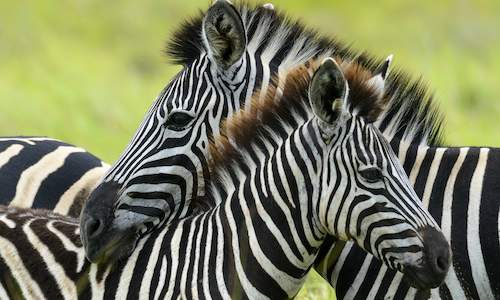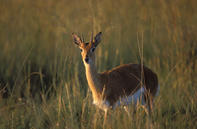
Oribi
Name
Oribi (Ourebia ourebi)
Order
Artiodactyla
Family
Bovidae
Appearance
Oribi rams measure about 600 mm at the shoulders with a weight of 11 to 17 kg. Ewes are slightly bigger than rams, weighing 8 to 20 kg. They are elegant, small antelopes with slim, long necks and legs.
Their coats are reddish-brown in colour with white underparts and black tails. Near the inner corners of their eyes, they have two large preorbital glands. Only rams have horns – short, straight and ringed at the base, measuring 80-180 mm. Oribis distinctively pronk when alarmed, leaping upward with an arched back and straightened legs.
Oribi Diet
This species is primarily a grazer, at times browsing on forbs. It populates flood plain but is not wholly dependent on permanent water sources.
Oribi Breeding
After a gestation period of 210 days, a single lamb is born. Mothers hide their lambs for a month after their birth, returning to suckle her offspring. Lambs are weaned at four or five months of age. Oribis are seasonal breeders, with births peaking in South Africa during November and December.
Oribi Behaviour
Oribis live in small monogamous groups of two ewes and a ram. Young rams are evicted from the family group by territorial rams, and ewes remain with the group until they are ready to form their own pairs. Maintaining social bonds is pertinent to this species.
Therefore, a family regularly performs a dunging ceremony. The dunghills are not kept. Family groups are territorial, defending their area of land - 25 to 100 hectares in size.
Oribi Habitat
The oribi prefers floodplains, open plains, grasslands, mountainous grasslands and light bushland as its habitat.
Where They Are Found
In South Africa, the oribi can be found in northern parts of the Eastern Cape, KwaZulu-Natal and Mpumalanga. Smaller populations live in the northeastern Free State and Swaziland. They are scarce in Namibia’s Caprivi Strip and the northeastern regions of Botswana.
Spoor Description
The oribi’s hooves point forward and its hind foot is elongated. Its spoor is smaller than that of the steenbok.

Learning about the mammals of South Africa is now so much easier for all South Africans - SouthAfrica.co.za is an excellent source of inform...
more
 Learning about the mammals of South Africa is now so much easier for all South Africans - SouthAfrica.co.za is an excellent source of inform...
Learning about the mammals of South Africa is now so much easier for all South Africans - SouthAfrica.co.za is an excellent source of inform...